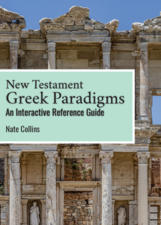The following is a guest post by Nate Collins (PhD candidate, Southern Seminary), the creator of New Testament Greek Paradigms: An Interactive Reference Guide.
When I first started learning New Testament Greek during my early grad-school days, my second-hand copy of Bill Mounce’s classic grammar textbook was a constant companion. I deeply resonated with his morphological approach to learning Greek grammar in those early years, in large part because I recognized the wisdom of learning principles and patterns of word formation instead of memorizing paradigm after paradigm after paradigm. (For non-language nerds, “morphology” refers to how words are formed, often in relation to the way they are used in a particular sentence.)
After my first semester of teaching a seminary-level introductory course on Greek grammar, however, I realized that I had been operating under the assumption that teaching Greek morphology was somehow sufficient in itself, leaving no room at all for any kind of rote memorization. Like countless other life lessons, a balance between the two must be struck. In the case of learning Greek, the morphological principles themselves must be memorized, but one must also practice applying them in order to gain a deeper understanding of word formation and therefore build a lasting foundation for learning how to use the language.
In order to aid this process for students, I have developed a digital collection of noun, adjective, and verb paradigms and organized them together in a single, easy-to-use interactive ebook that is now available on the iBookstore. Furthermore, even though the resource is optimized for mobile viewing (with on-screen navigational icons and buttons that enable users to toggle between various related paradigms), the resource can also be viewed on any Apple device with iBooks installed, including desktop and laptop computers (not recommended for iPhone 4s or earlier).
Finally, I built the collection with students in mind, who ought to—at least in my opinion—eventually learn how to reproduce paradigms on-demand. In order to make this learning process easier and more streamlined, a button at the bottom of each paradigm will temporarily hide every form on the current chart while students are trying to memorize the paradigm. If the student can’t remember a particular form, he or she can simply touch the button on top of that form and the word will reappear… and only that word. By keeping the rest of the paradigm hidden students can more easily force themselves to remember the other forms of the paradigm.
Biblical language study is too important to spend an entire semester (or two) learning the principles of grammar and morphology, only to forget the practical function of these principles by not mastering the process of using them. Don’t shortchange the process. Learn the basics of declension endings, personal endings, theme vowels and tense formatives… and then practice using this knowledge in drill after drill after drill. Five years later, when you are neck-deep in sermon preparation and church ministry, you will be grateful for this phase of basic training.
Find it here on the iTunes store.
Nate also wants to give away a copy of his new e-book! Enter below to win.

